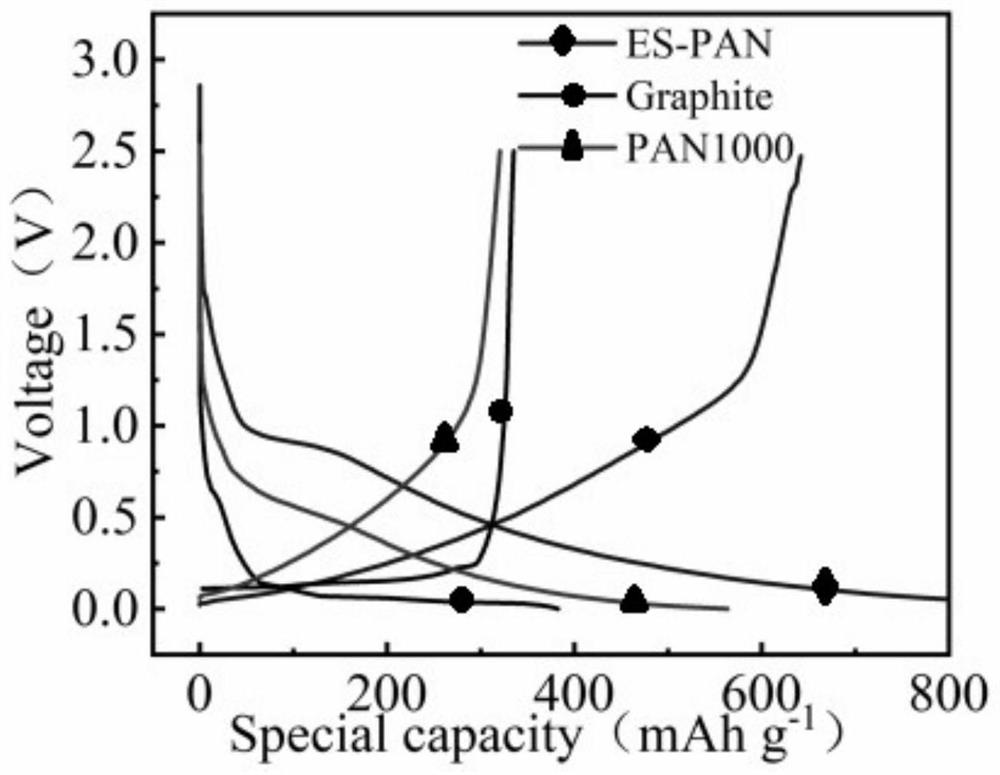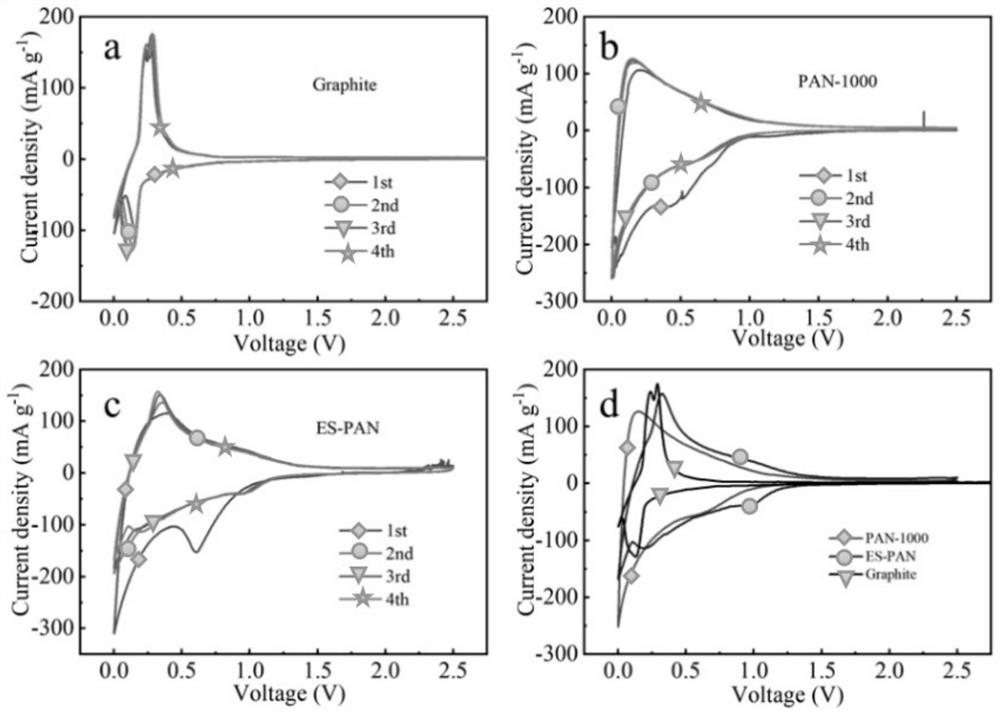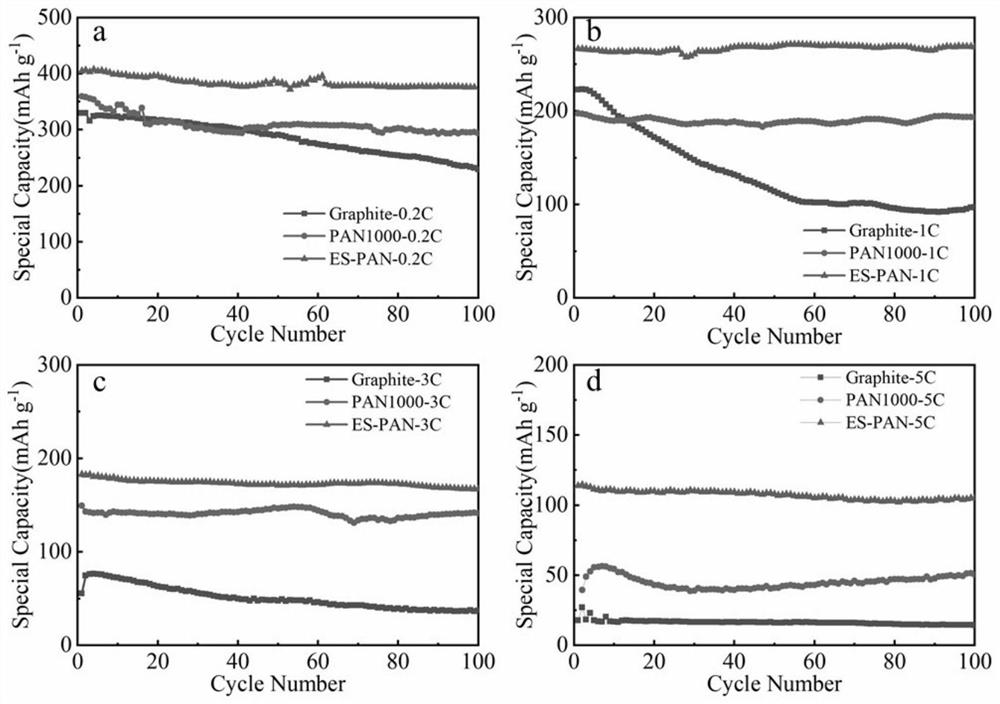High-performance lithium ion battery polyacrylonitrile carbon fiber negative electrode material and preparation method thereof
A polyacrylonitrile carbon fiber, lithium ion battery technology, applied in battery electrodes, secondary batteries, chemical characteristics of fibers, etc., can solve the problems of poor rate performance of layered graphite negative electrodes, increased lithium ion diffusion resistance, and small interlayer spacing. , to achieve the effect of increasing charge specific capacity, improving charge and discharge performance, and stable layered structure
- Summary
- Abstract
- Description
- Claims
- Application Information
AI Technical Summary
Problems solved by technology
Method used
Image
Examples
Embodiment 1
[0031] Step 1, PAN (polyacrylonitrile) powder is dissolved in DMF (N,N-dimethylformamide) solvent by mass percentage 13%, wherein PAN powder 1.95g, DMF solution 13.05g, keep stirring on the magnetic stirrer 12h obtain spinning solution;
[0032] Step 2, transfer the spinning solution to a 10ml syringe, install a stainless steel flat needle, the needle is a No. 20 needle, adjust the liquid flow rate to 1.2ml / h, the voltage to 18KV, and the acceptance distance to 15cm to observe a relatively stable nanometer Fibrous filaments, PAN precursors are obtained after continuous spinning for several hours;
[0033] Step 3, pre-oxidation: put the PAN precursor in a porcelain boat, in a tube furnace, in an oxygen atmosphere, raise the temperature from room temperature to 280 °C at 1 °C / min, keep it warm for 2 hours, and cool to room temperature to obtain a pre-oxidized wire;
[0034] Step 4, carbonization: heat the pre-oxidized filament from room temperature to 650°C at 1°C / min in a nitr...
Embodiment 2
[0037] Step 1, PAN (polyacrylonitrile) powder is dissolved in DMF (N,N-dimethylformamide) solvent by mass percentage 10%, wherein PAN powder 1.00g, DMF solution 9.00g, keep stirring on the magnetic stirrer 12h obtain spinning solution;
[0038] Step 2, transfer the spinning solution to a 10ml syringe, install a stainless steel flat needle, the needle is a No. 20 needle, adjust the liquid flow rate to 1.0ml / h, the voltage to 15KV, and the acceptance distance to 10cm to observe a relatively stable nanometer Fibrous filaments, PAN precursors are obtained after continuous spinning for several hours;
[0039] Step 3, pre-oxidation: put the PAN precursor in a porcelain boat, in a tube furnace, in an oxygen atmosphere, raise the temperature from room temperature to 280 °C at 1 °C / min, keep it warm for 2 hours, and cool to room temperature to obtain a pre-oxidized wire;
[0040] Step 4, carbonization: heat the pre-oxidized filament from room temperature to 650°C at 1°C / min in a nitro...
Embodiment 3
[0043] Step 1, PAN (polyacrylonitrile) powder is dissolved in DMF (N, N-dimethylformamide) solvent by mass percentage 18%, wherein PAN powder 1.50g, DMF solution 6.80g, keep stirring on the magnetic stirrer 12h obtain spinning solution;
[0044] Step 2, transfer the spinning solution to a 10ml syringe, install a stainless steel flat needle, the needle is a No. 20 needle, adjust the liquid flow rate to 1.7ml / h, the voltage to 20KV, and the acceptance distance to 18cm to observe a relatively stable nanometer Fibrous filaments, PAN precursors are obtained after continuous spinning for several hours;
[0045] Step 3, pre-oxidation: put the PAN precursor in a porcelain boat, in a tube furnace, in an oxygen atmosphere, raise the temperature from room temperature to 280 °C at 1 °C / min, keep it warm for 2 hours, and cool to room temperature to obtain a pre-oxidized wire;
[0046]Step 4, carbonization: heat the pre-oxidized filament from room temperature to 650°C at 1°C / min in a nitro...
PUM
| Property | Measurement | Unit |
|---|---|---|
| particle diameter | aaaaa | aaaaa |
Abstract
Description
Claims
Application Information
 Login to View More
Login to View More - R&D
- Intellectual Property
- Life Sciences
- Materials
- Tech Scout
- Unparalleled Data Quality
- Higher Quality Content
- 60% Fewer Hallucinations
Browse by: Latest US Patents, China's latest patents, Technical Efficacy Thesaurus, Application Domain, Technology Topic, Popular Technical Reports.
© 2025 PatSnap. All rights reserved.Legal|Privacy policy|Modern Slavery Act Transparency Statement|Sitemap|About US| Contact US: help@patsnap.com



